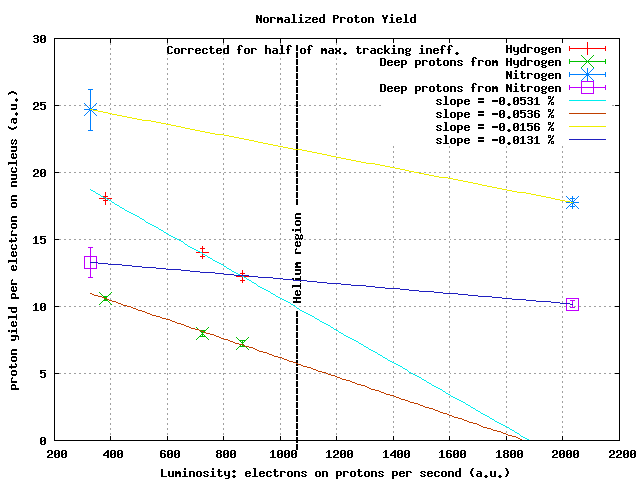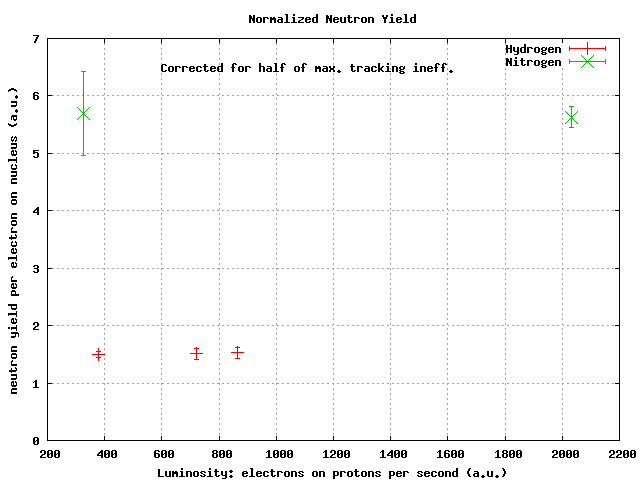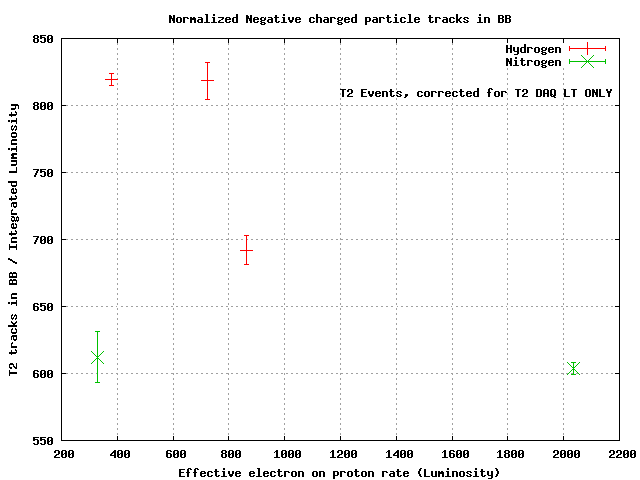Luminosity Dependence
|
Luminosity Dependence of the Proton and Neutron yields
|
We observe that the ratio of neutrons to protons identified by the neutron detector changes with luminosity. This was tracked to a decrease in the normalized (after corrected for electronic and DAQ deadtime, and an estimate of the tracking efficiency) proton yield as the luminosity increased, while the neutron yield is largely insensitive.
A few definitions:
During kin4, we took runs on the Hydrogen- and Nitrogen-filled reference cell at a couple of different beam currents, and (accidentally) at two different pressures for the Nitrogen cell. The runs used for this study and their conditions are in the table below:
The atomic densities of the hydrogen and nitrogen targets are about 17.8amg, while the helium-3 target had an atomic density of 10.7amg.



The effect on the 'dilution factor' for Helium-3 (the fraction of detected neutrons that left the target as neutrons) of using the ratio from the different luminosity conditions:
Presently we are using a dilution factor of Dn = 0.658 calculated from all the available data and assuming the ratios were independent of luminosity.
To look into this, I have looked into a couple of items.
Also looked at the BB tracking yield per Coulomb for T2 triggers. The image below shows the number of tracks found in BB with B.tr.p0>0 for T2 triggers. The track yield is normalized by the density of protons in the target, the accumulated charge, and corrected for the T2 DAQ livetime. The red points are from the hydrogen runs at different currents, and green from the nitrogen runs at different pressure.

Four of the points show a stable tracking efficiency as the luminosity changed. However the highest current Hydrogen run 4596 shows a ~15% drop compared to the other hydrogen runs, due to the MWDC's dropping out during the middle of the run. Correcting the accumulated charge, neglecting this period, leads to T2-tracks/Coloumb that is independent of luminosity.
A few definitions:
- Events were selected that had an electron in BigBite with an amplitude in the preshower greater than 450 (B.ts.ps.e>450), and a calculated W in the range 0.8<W<1.15 GeV.
- The missing momentum between the "cluster" in the neutron detector and the virtual photon were in the range |Ppar-q|<250 MeV/c, |Pperp|<150 MeV/c.
- Protons were identified as clusters with geometrically matching veto hits in BOTH v1 and v2 within +/-10ns of the cluster's time.
- Neutrons were clusters WITHOUT a veto hit within 3 veto bars in BOTH v1 and v2, in the time range -110ns to +10ns around the cluster's time.
During kin4, we took runs on the Hydrogen- and Nitrogen-filled reference cell at a couple of different beam currents, and (accidentally) at two different pressures for the Nitrogen cell. The runs used for this study and their conditions are in the table below:
| Run Range | Beam Current | Target Pressure(psi) | A | Z | N(neutrons) | N(protons) | LT(elect.) | LT(DAQ) | Tracking Eff. | Q |
| 4425-4427 | 2.55 | 149 | 1 | 1 | 1062 | 12824 | 0.933 | 0.931 | 0.934 | 5.67 |
| 4596 | 5.8 | 149 | 1 | 1 | 260 | 2082 | 0.785 | 0.744 | 0.646 | 2.38 |
| 4597 | 4.85 | 149 | 1 | 1 | 226 | 2101 | 0.811 | 0.840 | 0.767 | 1.67 |
| 4583 | 1.95 | 24 | 14 | 7 | 60 | 260 | 0.916 | 0.954 | 0.958 | 0.513 |
| 4585 | 1.95 | 149 | 14 | 7 | 981 | 3097 | 0.846 | 0.839 | 0.872 | 1.76 |
The atomic densities of the hydrogen and nitrogen targets are about 17.8amg, while the helium-3 target had an atomic density of 10.7amg.
The effect on the 'dilution factor' for Helium-3 (the fraction of detected neutrons that left the target as neutrons) of using the ratio from the different luminosity conditions:
- using the low-luminosity values for the ratios from Hydrogen and Nitrogen gives Dn(lowL) = 0.94;
- with the high-luminosity values for both reference-cell targets gives Dn(highL) = 0.42;
- extrapolating (interpolating) the Ratio for Hydrogen (Nitrogen) to the Helium region gives Rh=0.138 (Rn=0.2675), and a dilution factor of Dn(He3L) = 0.54.
Presently we are using a dilution factor of Dn = 0.658 calculated from all the available data and assuming the ratios were independent of luminosity.
To look into this, I have looked into a couple of items.
- The number of "deep" protons (that penetrate more than 2 layers of the neutron detector) displays the same trend (see above figure).
- The front-end deadtime of the veto detectors varied across the detector plane for the left bars, but was not greater than 110ns.
- A calculation of the deadtime due to the change of the rate on the vetoes, however it does not appear sufficient to account for the dropping proton efficiency. At the highest luminosities for Hydrogen, the rate for an individual veto bar tops-out at 120 kHz, which assuming a 110ns deadtime leads to a loss of at most 1.3% of the protons ("correct" signal blocked by accidental hit). This insufficient to explain the ~30-40% drop in proton yield between the lowest and highest luminosity H2 runs. Also note: a single spurious hit in the right region should ALSO block neutron identification and reduce the neutron yield, which is not observed.
- V2 Bar 37 Right TDC is missing in the later data.
Also looked at the BB tracking yield per Coulomb for T2 triggers. The image below shows the number of tracks found in BB with B.tr.p0>0 for T2 triggers. The track yield is normalized by the density of protons in the target, the accumulated charge, and corrected for the T2 DAQ livetime. The red points are from the hydrogen runs at different currents, and green from the nitrogen runs at different pressure.
Four of the points show a stable tracking efficiency as the luminosity changed. However the highest current Hydrogen run 4596 shows a ~15% drop compared to the other hydrogen runs, due to the MWDC's dropping out during the middle of the run. Correcting the accumulated charge, neglecting this period, leads to T2-tracks/Coloumb that is independent of luminosity.
Created by: feuerbac last modification: Friday 08 of June, 2007 [17:27:16 UTC] by feuerbac
The original document is available at http://hallaweb/tiki-index.php?page=Luminosity%20Dependence